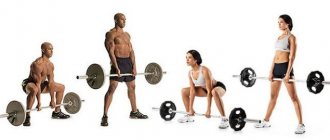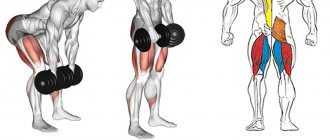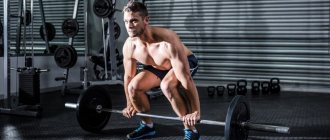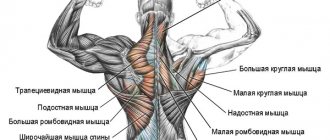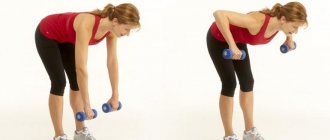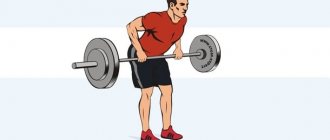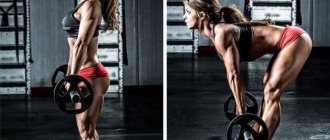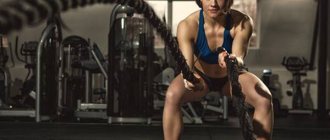Perhaps no other exercise builds strength and muscle mass as much as the deadlift. When performing it, the most terrible faces are made. Overcome your fear and do a deadlift in front of the mirror.
For powerlifting, the deadlift is the main impetus for increasing strength and testosterone production. Deadlift is traumatic and requires technically correct movements and manipulations by athletes. The exercise heavily utilizes the back muscles and stabilizers. Depending on the goals of athletes, it is customary to divide deadlifts into 4 types: deadlift, classic, sumo and trap bar deadlift.
Classic deadlift
Before performing the exercise, you need to stand near the bar, placing your feet at a small distance from each other, but close to the bar. It is allowed to lightly touch it with the front part. This type of deadlift will be easy for bodybuilders with undeveloped legs and short arms. The physical ability to achieve results and lift maximum weights in an exercise like the deadlift depends on the anatomy of the body and its features.
The variation in the technique of performing the exercise depends on the height of the bodybuilder, the length of his arms and legs. If you have a weak grip, then you need to use additional bodybuilding accessories like belts, which is not allowed in competitions.
How to replace deadlifts
If there are contraindications to the deadlift, it can be excluded from the training program and replaced with more gentle exercises:
- Leg curls in the machine are the main isolation exercise for working the hamstrings;
- The buttocks are trained by squats;
- Hyperextension is good for working the back extensor muscles.
In bodybuilding, the deadlift is not at all an indispensable movement; many people train without it and achieve excellent results. You should not do this exercise if you have problems with your spine, as this will make them significantly worse.
Deadlift: execution technique
When performing the exercise, place your feet shoulder-width apart or in a parallel plane. You need to grab the barbell with a straight grip, preferably slightly wider than shoulder-width. You need to raise your head and look up. The shoulders are pulled back, the pelvis is lowered, and a deflection appears in the lower back.
If the pelvis is positioned at a low point, then when you jerk from a standstill, the load will fall on the quadriceps. If the pelvis is high, then the entire load will fall on the lower back. When you pull the barbell, you need to press the floor with your heels. There is no need to focus on lifting the weight up, watch your heels.
The barbell must be held close to the legs, as close to them as possible. The knees extend when the bar is halfway through and near the mid-thigh. The torso must be straightened, while moving the shoulders back and fixing the weight.
The bar lowers slowly, without hitting the bar on the floor, avoiding injury. You need to touch the floor lightly with the pancakes, then pull straight up. It is always necessary to monitor and control all phases of lifting. When performing deadlifts, be sure to use a belt.
IMPACT OF DEADLIFT ON THE ATHLETE’S BODY
It is not at all necessary to play sports professionally. However, a few hours a week spent in the gym can change our lives for the better. And among the basic exercises that give the maximum effect, the deadlift should be highlighted. Many beginners who perform this exercise with poor technique experience pain in the spine. In order to avoid possible injuries, it is necessary to perform deadlifts in strict accordance with the instructions of the trainer. Then it will turn into a powerful tool for improving your own body.
The level of comfort that modern technology provides to a person is truly impressive. He can order pizza for a group without getting up from his chair, chat on Skype with a friend living on another continent, and earn thousands of dollars without leaving his home. Now he can minimize his physical activity - all the equipment is designed to prevent his slightest whim. But what makes our life comfortable and simple can cause irreparable harm to our body. A sedentary lifestyle causes many diseases, and only sports can overcome them.
Experienced bodybuilders know that deadlifts, performed correctly, are not only incapable of harming the spine, but can also speed up recovery processes after injury and improve the athlete’s posture.
The beneficial effect of deadlifts on the athlete’s body is explained simply: the longitudinal muscles of the back, forced to work intensively, help improve blood circulation in this area. And thanks to the accelerated blood flow along the spinal column, all recovery processes are accelerated. Only manual therapy can give a similar effect.
If a bodybuilder has not performed this exercise before, he should definitely introduce it into his training program. Thus, he will be able to make a qualitative leap in gaining mass and strength. The deadlift perfectly develops the trapezius and lower back muscles, giving the back a beautiful strength profile. In addition, this exercise actively develops the quadriceps and hamstring muscles. Also, muscles such as biceps, calf muscles, forearms, abs and other muscle groups are indirectly involved in deadlifting.
It's best to start learning deadlifts using light weights. This is done from a semi-squat position (on slightly bent legs); the back should be arched.
After the back muscles have become a little stronger, it will be necessary to increase the weight of the barbell, but you should always ensure that the technique is correct.
After just six sessions, the bodybuilder begins to feel how correctly he performs the deadlift. And then he will be able to feel the line, crossing which he risks getting injured. As you know, the spine is the most important center of all our motor functions, so damage to it can put an athlete out of action for a long time.
A good warm-up will help make your workout safer. This is a well-known fact, but, nevertheless, many people neglect warm-up. And since there are many tendons in the lumbar region, which, when not warmed up, are characterized by low elasticity, warming up is simply mandatory before performing a deadlift. Otherwise, even a slight load can cause sprains and tears.
Deadlift
The straight-legged deadlift, or deadlift as it is commonly called, is performed without bending the knees. The back must be arched in the lumbar region, and the legs must not bend. Deadlifts are not listed as competitive exercises.
The weight that is lifted is far from the maximum; it is easy to get injured. The most effective effect is felt by all back muscles.
Recommendations for implementation
In order for the exercise to be fully effective, and its implementation does not bring any negative consequences, you need to follow some simple recommendations:
- Pay special attention to warming up and warming up, this will contribute to a productive workout and help avoid injury.
- Be responsible when choosing shoes - they should be stiff enough and have good grip on the surface.
- To minimize the risk of injury and create additional chest pressure, use a belt. But it is better to use the belt only when working with weights; the rest of the time, take it off.
- If you feel tired arm muscles or weak grip, it is advisable to use wrist straps.
- As with any strength exercise, do not forget about breathing: effort - inhale (preferably through the nose), relaxation - exhale.
- The rule for selecting the optimal working weight for deadlifts for women: if after performing 12 repetitions you do not feel tension and slight fatigue, you should add weight.
Did you know? For all types of deadlifts, correct technique is of paramount importance; weight is of secondary importance. Therefore, it is better (especially at the very beginning, while the technique is damp) to practice in front of a mirror.
Risks and injuries
A very traumatic and technically difficult exercise. If performed incorrectly, the risk of injury is quite high. Often these are spinal hernias or other sprains and disorders of the back and nerves.
When the back is not arched, but straight, there is a huge load on the intervertebral discs. In order to do deadlifts, you must first strengthen your lower back and holders with hyperextension. Be sure to use a belt and do not pull the barbell if you have a weak spine or a hernia.
Author: ForceMan from 08/28/2015, 02:07
- 0
Frequent mistakes during classes
As already mentioned, the deadlift is a fairly traumatic exercise. To minimize the risk of injury, you should avoid common mistakes, including the following:
- Warm up. This is a key element of any training, especially strength training. The duration of the warm-up can be as long as the workout. Poorly warmed muscles, ligaments and undeveloped joints are highly likely to lead to injury. After a good warm-up, you should start strength exercises with minimal weight (the first set), and only then go to the working weight.
- To perform Romanian deadlifts, girls often work with fairly heavy weights. You should not bring the weight to the prohibitive level. Technique should take precedence over weight. Based on this rule: you should be able to do 4 sets of 14–18 repetitions. Your muscles should feel tense at the end of each approach; there is no need for it to become painful.
- Do not round your back under any circumstances. Firstly, this can lead to injury, and secondly, this circumstance significantly reduces the effectiveness of the exercise.
- You should not bend your lower back too much or straighten your shoulders excessively, this is dangerous for the shoulder joints.
- Your elbows should not be involved in any way in the deadlift at all. They are constantly unbent and do not start working under any conditions. Of the arm joints, only the wrist and shoulder joints take part in performing deadlifts.
- No jerking! Traction implies smoothness, even some slowness in movements.
Load distribution
The deadlift is one of the three main basic exercises, the implementation of which leads to a comprehensive increase in strength and muscle mass.
Without this exercise, it is very difficult to make significant progress in muscle development. When performing a deadlift, about 70% of the muscles of the entire body are involved in the work. This is a powerful, energy-consuming exercise that also has a functional basis. Main working groups: - Back muscles. The main load falls on the extensors of the spine, especially their lumbar part. Also, part of the work goes to the latissimus dorsi muscles. - Legs and buttocks. The exercise makes the hamstrings, gluteus maximus and quadriceps muscles actively work. It’s worth saying here that the classic style of deadlifting puts less stress on the buttocks and the back of the thighs, so it is more suitable for men, but, for example, the Romanian deadlift and straight-legged deadlift are traditionally considered a more suitable option for women. Additional load is received by: - Forearms and hands. Holding a heavy barbell is not the easiest task for your hands. - Trapezius muscles. - Abdominal muscles (rectus and obliques). They stabilize your core, helping you maintain proper, safe posture. - Calf muscles, inner thighs.
Execution technique - Take an empty bar (usually its weight is 20 kg), stand in front of it, placing your feet slightly narrower than your shoulders. The feet should be parallel to each other. — Straighten your back, push your pelvis back (natural arch in the lower back). The back cannot be round. — The neck is an extension of the back; there is no need to raise or lower your head. From this position, we tilt the body forward, moving the pelvis back. With this tilt, the shoulders should extend slightly forward beyond the line of the shins. - The knees will begin to bend (by 10-15 degrees) - this is normal. — The tilt of the body should be 40-45 degrees. - Put your hands down. If you are bending over correctly, your hands should be in line with the front of your shins. There should be very little left to the neck. - Sit down to take it. At the same time, do not lean your body forward or backward. Your main task is to ensure that your shoulders move along a strictly vertical axis. - Take the bar with the correct grip (palms facing you). — Smoothly straighten your legs, and only then straighten your back. When you hang weights on the bar, you won't have to go as low to grab the barbell. Therefore, you just need to approach it so that the bar rests on your shin. From this position it will need to be raised. - When you are straight, bring your shoulder blades together. Then start lowering - first your back bends to about 45 degrees (make sure your shoulders are exactly above the bar), then your legs.
A set of exercises for the back at home
Of course, this complex will only include those exercises that can be done AT HOME, and for which you do not need a huge barbell and special exercise equipment. We will advise you the most optimal. So, let's begin.
Pushups. It is enough to perform only classic push-ups to thoroughly warm up your back and feel the burning sensation in the muscles. There is no specific number of approaches and repetitions. Do as much as you can.
Pull-ups on the horizontal bar to the chest. In order to pump up your back on the horizontal bar, you need to stretch not with your chin, as taught in school, but with your chest. At the same time, the shoulder blades are brought together, and the back is tensed as much as possible. We also do as much as we can.
Dumbbell row. Performed alternately with each hand; if desired, the dumbbell can be replaced with a kettlebell. Starting position - standing, torso tilted parallel to the floor, one hand holding the support, the other holding the equipment. We pull the load towards the back, the elbow moves parallel to the torso. We do 4 sets of 12-15 repetitions.
Deadlift. A complex exercise in technique, and even more so as a back exercise at home. And, perhaps, we will devote a separate block of our article to him.
Security measures
When performing deadlifts, you need to take some precautions:
- If you experience pain in the pelvis, lower back, or joints, you should stop exercising.
- People suffering from varicose veins, chronic fatigue syndrome, and musculoskeletal diseases should be extremely careful about such exercises.
- During the exercise, the lower back is maximally loaded. It is precisely because of the risk of injury to this part of the spine that the described technique for performing the exercise must be strictly followed.
Deadlifts for girls have long and firmly occupied a firm position among the main exercises of most fitness programs. This is due to the fact that in addition to the formation of beautiful toned shapes (especially the hips and buttocks), regular exercise helps to lose weight, and this is especially important for the fair sex.
Deadlift what muscles work?
The deadlift is a unique basic multi-joint exercise that involves bending the knee and hip joints. At the same time, the ankle, elbow, shoulder joints, the entire spine, and especially the traumatic part of it, the lower back, are constantly under serious load.
If performed correctly, almost all the muscles of the body will be actively involved and the body will receive severe training stress. Primary muscles: hamstrings, quadriceps, glutes, erectors and latissimus dorsi. Secondary muscles: adductor muscles of the legs, forearms.
